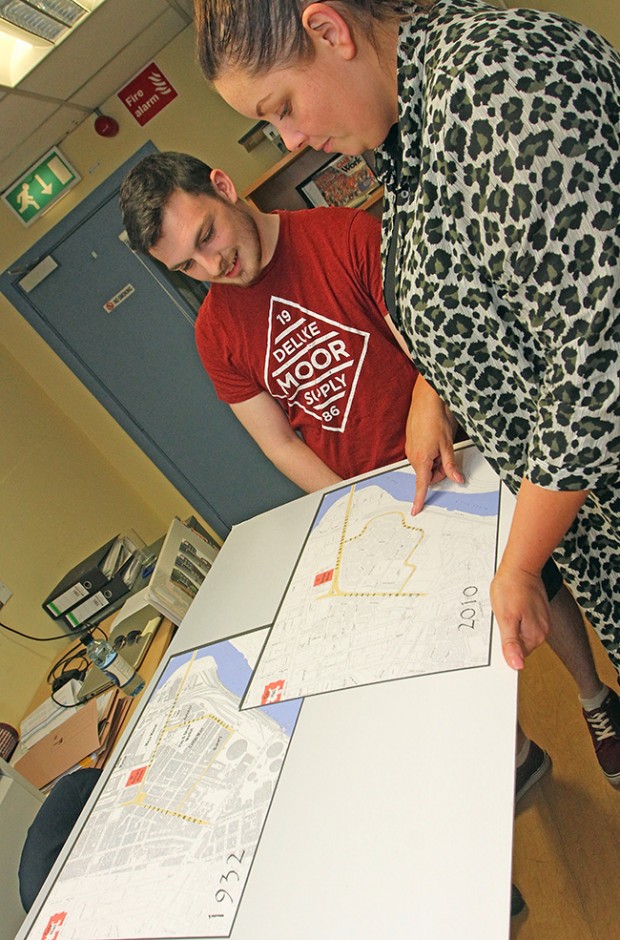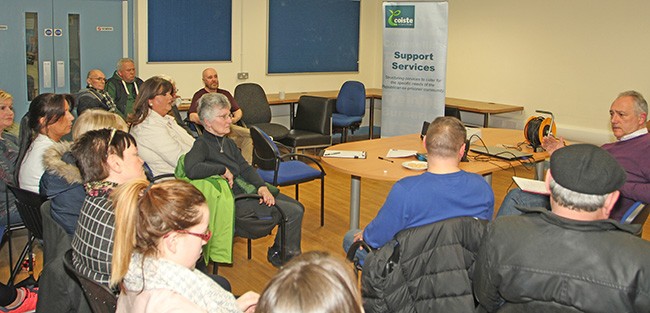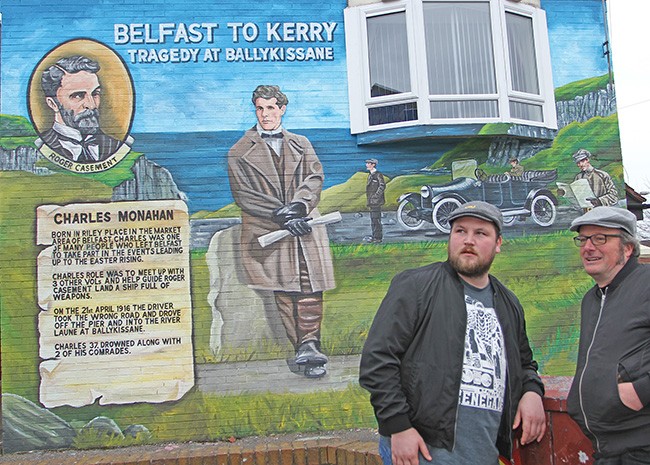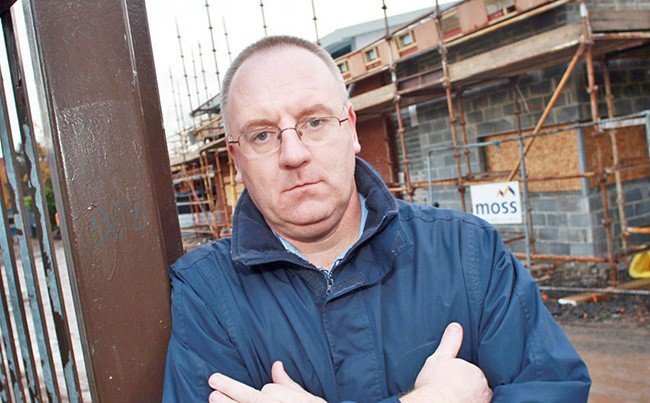1 June 2017 Edition
Fighting for the heart and soul of their community
The legacy of Gerard ‘Jock’ Davison and the ambition of Belfast’s Market Development Association

• Sinn Féin Councillor Deirdre Hargey with her brother, Fionntán, pointing out how the British military dictated the street plans as part of their strategy to control the population
ENTHUSED by the legacy and commitment of Gerard ‘Big Jock’ Davison, the Market Development Association (MDA) has embraced many of the projects that Davison championed as the MDA Regeneration Manager before he was shot dead by a gunman in May 2015.
On the second anniversary of Davison’s death An Phoblacht’s PEADAR WHELAN travelled to the Market area and met with members of the MDA and spoke to them about the man they see as “a hero, a defender of the area and an advocate for our community”.
TOO OFTEN when we read about or see news broadcasts reporting on small inner city areas of Belfast, Dublin, Derry, Cork or Limerick, the content is negative and disheartening.
Depressingly, the bad news tends to overshadow the positive acts of community action and resistance that, in a lot of instances, is the glue that holds these districts together.
This still stands true as we look back to the news headlines of two years ago after a lone gunman ambushed and killed Gerard ‘Jock’ Davison in the Market area of Belfast in May 2015.
Davison, a larger-than-life character, a committed republican and community activist, was gunned down at the junction of Lower Stanfield Street and Welsh Street as he walked to work in the Market Development Association (MDA). The MDA is an organisation that he put his heart and soul into as he fought to revive an area that was devastated by the war that raged in the North and the effects of deindustrialisation that impoverished a once-thriving community.
The mainstream media, in time-honoured fashion, vilified Davison and focused on his previous republican links and involvement in the IRA to present him as the villain of the piece rather than the victim. Indeed, their underlying message was to effectively say ‘he got what he deserved’.
As the lone gunman who killed ‘Jock’ took away his life, the press sought to take away his character and standing by linking him, without a shred of evidence, to numerous killings.
If it holds true that bad news dominates the news agenda when reporting inner city areas, it is equally true that there are plenty of people engaged in a massive amount of work motivated by a true community spirit.
Day in, day out, there is activity created, developed and sustained by individuals and groups inspired to rise above the mire of state indifference and in opposition to greedy developers and industrialists who only value people for their labour and whose goal is profit and self-aggrandisement

• Ex-prisoner and now Belfast City Councillor Séanna Walsh of Coiste na nIarchimí addresses republican ex-POWs and their families in the Market Community Centre as part the MDA's community engagement programme
The Market at war
For many people, particularly in the North, the Market in south Belfast, which adjoins Belfast City Centre, was synonymous with legendary ‘Official IRA’ leader Joe McCann, who was shot dead by British Army paratroopers in May 1972.
McCann’s celebrated status grew in the aftermath of the internment raids of 9 August 1971, when British troops invaded nationalist areas of the North and dragged hundreds of republicans off to internment camps, provoking some of the worst clashes of the conflict between nationalists and British forces.
On 10 August, a group of six Official IRA members, led by McCann, took over Inglis’s Eliza Street bakery in the Market area. In the fierce gun battle that ensued, McCann’s unit pinned down a large contingent of British soldiers.
The epic photograph of McCann taken during the gun battle, of him silhouetted in the flames of a blazing van as he crouched with an M1 carbine and a Starry Plough flag fluttering above him, reinforced his status as a guerrilla fighter and reflected the spirit of resistance in the Market areThe Market, as with many nationalist enclaves throughout the North, experienced the wrath of the British military and their Royal Ulster Constabulary allies in the course of the war.
Needless to say, the area was also subjected to unionist terror with death squads carrying out the wishes of their British puppet masters and targeting residents.
The clear links between the British state forces and unionist killers was obvious in the assassination of Brendan ‘Big Ruby’ Davison when, in 1988, Ulster Volunteer Force gunmen disguised as RUC policemen lured the veteran IRA Volunteer to open his front door in Friendly Way, where they shot and killed him. The murdered man was ‘Jock’ Davison’s uncle.
The Davisons, like many others in the district with a republican tradition, became active in the IRA as the war intensified across the North and ‘The People’s Army’ fought back.
In a paper delivered as part of the Market Social Education Project, Fionntán Hargey of the MDA gave a snapshot of life in the area and outlined how a veteran of the time described life in the late 1960s and early 1970s as the old certainties of unionist domination were shaken to their foundations.
“In the Market they even started a co-operative shop. It sold food and household stuff; sold everything at cost price.
“Some things were bought wholesale, some things ‘fell of the back of a lorry’. Big Joe McCann would say: ‘It’s not stealing, it’s commandeering.’
“The shop ran for a number of years, into the 1970s, but the Brits continually came in and wrecked it. Then internment came and all the men were gone – locked up. The shop struggled to run anymore. The Brits killed it off.”
Another veteran of the time told Hargey:
“Even with all these defeats and setbacks, things had changed. All along it was empowering.
“Despite all of our struggles, the threats and the intimidation, the arrests and the beatings, we could see things changing. The seed had been planted in us. We knew a better Ireland, a better life for working-class people was possible, and we were prepared to take a stand together and fight for it.
“There was no going back to the old ways.”

• Travellers' rights activist and actor John Connors with Dublin historian Lorcan Collins at the mural painted in tribute to Volunteer Charlie Monahan (Charlie was born in the Market), who died on Good Friday 1916 as he travelled to guide Roger Casement ashore with the weapons from 'The Aud'
The battle against the developers
In line with the British military’s counter-insurgency strategy of containment, the old Market, with its old terraced streets that reached out to East Bridge Street on one side and across Cromac Street into Belfast City Centre on the other, was bulldozed.
The modern homes that replaced the old ‘two-up, two-down’ houses had indoor toilets and bathrooms were welcomed by the residents. Behind this regeneration, however, lay British Army and intelligence services’ plans designed to contain and control the population. East Bridge Street was closed off with a single row of houses. The narrow Market streets that flowed into it like tributaries flowing into a main watercourse, providing unfettered access to the city centre, were dammed shut.
On the other side, the numerous streets that crossed Cromac Street, linking it with Joy and Alfred Streets on the City Centre side of the Market, were redesigned as cul-de-sacs, leaving the area with just two access roads running on to Cromac Street, which was also widened into a four-lane thoroughfare that cut the district in two.
Where the area was once an integrated inner city district, it was now marginalised.
Running in tandem with the British military/security strategy, the industries such as the markets (from where the area gets its name), the tanneries, bakeries and other commercial enterprises migrated to new sites.
So the community that benefited from these industries now found itself marginalised on a second front.
The battle against this marginalisation is now being fought against the developers and the hedge-funders whose insatiable appetite for profit goes on.
Hargey says of the Peace Process which heralded the end of the armed conflict and led to the Good Friday Agreement:
“The Market saw massive amounts of investment and development around it. Lanyon Place witnessed the construction of the Waterfront Hall, Hilton Hotel and the BT Tower but the local community continued to be marginalised and excluded.”
Hargey slammed those behind the redevelopment who boasted how they walled up the East Bridge Street tunnels to ‘make sure they didn’t come over from the Market to steal cars’.
Hargey said:
“Against the grain of our earlier history as part of the city’s commercial life, redevelopment was being used as an excuse to criminalise and squeeze our people out of Belfast’s economic life.”
It is these tunnels, a signature project of the MDA under Gerard Davison as he fought to break the stranglehold that developers and planners have on the area, which are a priority for the MDA as they continue his work.
At the heart of the scheme are eight tunnels that run under East Bridge. The MDA plans to develop these as part of a wider social economy scheme involving a crèche, coffee shops and a health and bike hire project.
Crucially, the scheme is aimed at reconnecting the Market community with Belfast City Centre, its natural hinterland.
Even though there has been initial support for the scheme, Belfast City Council’s Planning Department has approved a massive development at Stewart Street.
Sinn Féin Councillor Deirdre Hargey said:
“This will not only cut the community off even further from the city centre but from the very tunnels themselves. At 14 storeys, this is not only a massive overdevelopment of the site but development on steroids.”
This decision, coupled with the Planning Department’s attempt to rezone land designated for social housing for commercial development on the Gasworks site on the southern edge of the Market has enraged a community who see their needs being superseded by private developers.
Fionntán Hargey said:
“The forces ranged against our community have vast wealth on their side. They have almost limitless resources to call upon. They have a dizzying array of political influence and international financial connections.
“We don’t have their wealth; we don’t have their resources; we don’t have their international financial connections or political influence.
“But what we do have is a history of resistance. What we do have is a tradition of struggle. And we have a wealth that they can’t buy – our own people.”
A champion inspired by Bobby Sands

GERARD DAVISON was a socialist republican whose aspirations for his community saw him oppose the military and economic repression of that community. Inspired by his hero IRA Volunteer Bobby Sands’s dictum that everyone, young or old, has their part to play, Davison acted as a role model for many.
These include the young activists in the area whose projects such as the Market Social Education Project has seen them establish a weekly book club focusing on such subjects as political economy. During May they had workshops discussing the ‘The Village Against the World’, the tale of Marinaleda, a village in Spain that has pursued co-operative programmes aimed at benefiting the whole community.
There’s also the Pangur Bán project, established in 2014, which promotes independent learning, communal solidarity and social pride through lectures, debates, concerts and drama.
Last year, the Centenary of the 1916 Easter Rising, they packed out the Waterfront Hall with a community-based play about the revolution in Dublin.
Travellers’ rights activist and TV/movie actor John Connors (Love Hate, King of the Travellers, and more) spoke to a packed hall about his life as a Traveller, an activist and a republican.
This is truly part of the legacy of Gerard ‘Jock’ Davison, a revolutionary community activist who led from the front.




